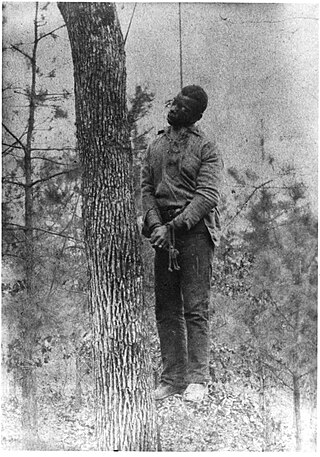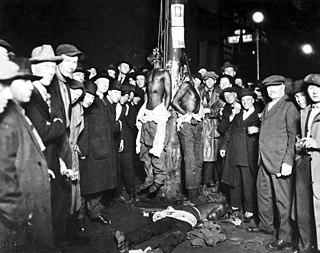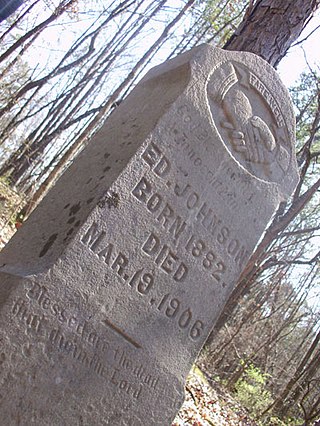
Coos Bay is a city located in Coos County, Oregon, United States, where the Coos River enters Coos Bay on the Pacific Ocean. The city borders the city of North Bend, and together they are often referred to as one entity called either Coos Bay-North Bend or Oregon's Bay Area. Coos Bay's population as of the 2020 census was 15,985 residents, making it the most populous city on the Oregon Coast. Oregon's Bay Area is estimated to be home to 32,308.

Sam Hose was an African American man who was tortured and murdered by a white lynch mob in Coweta County, Georgia, after being accused of rape.

William Dorsey Jelks was an American newspaper editor, publisher, and politician who served as the 32nd Governor of Alabama from 1901 to 1907. As Lieutenant Governor of Alabama, he also served as acting governor between December 1 and December 26, 1900, when Governor William J. Samford was out-of-state seeking medical treatment.
Mack Charles Parker was an black American victim of lynching in the United States. He had been accused of raping a pregnant white woman in northern Pearl River County, Mississippi. Three days before he was to stand trial, Parker was kidnapped from his jail cell in the Pearl River County Courthouse by a mob, beaten and shot. His body was found in the Pearl River, 20 miles west of Poplarville, 10 days later. Following an investigation by the Federal Bureau of Investigation, the men who killed him were released. Despite confessions, no one was ever indicted for the killing. Historian Howard Smead called the killing the "last classic lynching in America."

Lynching was the widespread occurrence of extrajudicial killings which began in the United States' pre–Civil War South in the 1830s and ended during the civil rights movement in the 1950s and 1960s. Although the victims of lynchings were members of various ethnicities, after roughly 4 million enslaved African Americans were emancipated, they became the primary targets of white Southerners. Lynchings in the U.S. reached their height from the 1890s to the 1920s, and they primarily victimized ethnic minorities. Most of the lynchings occurred in the American South, as the majority of African Americans lived there, but racially motivated lynchings also occurred in the Midwest and border states. In 1891, the largest single mass lynching in American history was perpetrated in New Orleans against Italian immigrants.

The Pickens County Courthouse in the county seat of Carrollton, Alabama is the courthouse for Pickens County, Alabama. Built-in 1877-1878 as the third courthouse in the city, it is noted for a ghostly image that can be seen in one of its garret windows. This is claimed to be the face of freedman Henry Wells from 1878.

On June 15, 1920, three African-American (Black) circus workers, Elias Clayton, Elmer Jackson, and Isaac McGhie, suspects in an assault case, were taken from the jail and lynched by a White mob of thousands in Duluth, Minnesota. Rumors had circulated that six Black men had raped and robbed a nineteen-year-old White woman. A physician who examined her found no physical evidence of rape.
James Cordie Cheek was a 17-year-old African-American youth who was lynched by a white mob in Maury County, Tennessee near the county seat of Columbia. After being falsely accused of attempting to rape a young white girl, Cheek was released from jail when the grand jury did not indict him, due to lack of evidence. The county magistrate and two other men from Maury County abducted Cheek from Nashville, where he was staying with relatives near Fisk University, took him back to the county, and turned him over to a lynch mob. The mob mutilated Cheek and murdered him by hanging. A grand jury declined to indict anyone for the murder of Cheek.
On May 16, 1918, a plantation owner was murdered, prompting a manhunt which resulted in a series of lynchings in May 1918 in southern Georgia, United States. White people killed at least 13 black people during the next two weeks. Among those killed were Hazel "Hayes" Turner and his wife, Mary Turner. Hayes was killed on May 18, and the next day, his pregnant wife Mary was strung up by her feet, doused with gasoline and oil then set on fire. Mary's unborn child was cut from her abdomen and stomped to death. Her body was then repeatedly shot. No one was ever convicted of her lynching.

On March 19, 1906, Ed Johnson, a young African American man, was murdered by a lynch mob in his home town of Chattanooga, Tennessee. He had been wrongfully sentenced to death for the rape of Nevada Taylor, but Justice John Marshall Harlan of the United States Supreme Court had issued a stay of execution. To prevent delay or avoidance of execution, a mob broke into the jail where Johnson was held, and abducted and lynched him from the Walnut Street Bridge.

Laura and L. D. Nelson were an African-American mother and son who were lynched on May 25, 1911, near Okemah, Okfuskee County, Oklahoma. They had been seized from their cells in the Okemah county jail the night before by a group of up to 40 white men, reportedly including Charley Guthrie, father of the folk singer Woody Guthrie. The Associated Press reported that Laura was raped. She and L. D. were then hanged from a bridge over the North Canadian River. According to one source, Laura had a baby with her who survived the attack.
Ell Persons was a black man who was lynched on 22 May 1917, after he was accused of having raped and decapitated a 15-year-old white girl, Antoinette Rappel, in Memphis, Tennessee, United States. He was arrested and was awaiting trial when he was captured by a lynch party, who burned him alive and scattered his remains around town, throwing his head at a group of African Americans. A large crowd attended his lynching, which had the atmosphere of a carnival. No one was charged as a result of the lynching, which was described as one of the most vicious in American history, but it did play a part in the foundation of the Memphis chapter of the NAACP.

In Forsyth County, Georgia, in September 1912, two separate alleged attacks on white women in the Cumming area resulted in black men being accused as suspects. First, a white woman reportedly awoke to find a black man in her bedroom; then days later, a white teenage girl was beaten and raped, later dying of her injuries.
Claude Neal was a 23-year-old African-American farmhand who was arrested in Jackson County, Florida, on October 19, 1934, for allegedly raping and killing Lola Cannady, a 19-year-old white woman missing since the preceding night. Circumstantial evidence was collected against him, but nothing directly linked him to the crime. When the news got out about his arrest, white lynch mobs began to form. In order to keep Neal safe, County Sheriff Flake Chambliss moved him between multiple jails, including the county jail at Brewton, Alabama, 100 miles (160 km) away. But a lynch mob of about 100 white men from Jackson County heard where he was, and brought him back to Jackson County.
On Tuesday, November 12, 1914, John Evans, a black man, was lynched in St. Petersburg, Florida, United States, by a mob of 1,500 white men, women and children. Evans was accused of the murder of Edward Sherman, a white real estate developer, and the attack of Sherman's wife, Mary. After word of the attack spread, and Mary Sherman claimed her attackers were "two negroes," a citywide search ensued. Suspicions immediately led to John Evans. Two days after the murder, a posse consisting of some of the city's most prominent and well-respected members stormed the St. Petersburg jail, threw a noose around Evans' neck and marched him to his death. He was never given a fair trial. Evans was hanged from a light post on the corner of Ninth Street South and Second Avenue. At first, he kept himself alive by wrapping his legs around the light pole. An unidentified white woman in a nearby automobile ended his struggle with a single bullet. Though the shot was fatal, the rest of the crowd began shooting at Evans' dangling body until their ammunition was depleted.
Raymond Arthur Byrd was an African-American farmhand who was lynched by a mob in Wythe County, Virginia on August 15, 1926.
Ephraim Grizzard and Henry Grizzard were African-American brothers who were lynched in Middle Tennessee in April 1892 as suspects in the assaults on two white sisters. Henry Grizzard was hanged by a white mob on April 24 near the house of the young women in Goodlettsville, Tennessee.

Amos Miller was a 23-year-old African-American man who was lynched from the balcony of the Williamson County Courthouse in Franklin, Tennessee, on August 10, 1888.
Christopher C. Davis was a Black man who lived near Albany, Ohio with his wife and two children. He worked as a farm laborer. In 1881, he was accused of raping and assaulting a White woman, after which he was arrested. While in jail in Athens, Ohio, before his trial, a mob of White men broke into the jail and lynched him by hanging him from a bridge over the Hocking River. None of the White men were indicted of a crime.










